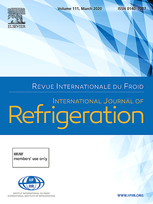
IIR document
Numerical investigation of transient thermo-fluid processes in a Ranque-Hilsch vortex tube.
Author(s) : MIRJALILI M., GHORBANIAN K.
Type of article: IJR article
Summary
A 2D numerical investigation is performed to better understand the transient thermo-fluid processes in a vortex tube for a cold mass fraction equal to 0.44. The results along the Ranque-Hilsch vortex tube reveal a close agreement with past numerical and experimental data. The distribution of axial, radial, and tangential velocities as well as the stagnation pressure and temperature are examined at different positions for different time steps. The results indicate that the tangential velocity is the most significant velocity component and dominates the heat transfer and energy conversion processes. In addition, it is evident that the core of the cold end experiences the highest pressure gradient along with almost zero tangential and radial velocities. The maximum axial velocity appears close to the inlet and its value increases with higher cold mass fractions due to higher pressure gradient which may lead to the enlargement of the inner vortex. The impact of different cold mass fractions in the range of 0.22-0.82 at tube length ratios x/L equal to 0.05, 0.5, and 0.9 for different time steps are examined. The results indicate that there is relatively no vortex decomposition near the cold outlet.
Available documents
Format PDF
Pages: 746-755
Available
Public price
20 €
Member price*
Free
* Best rate depending on membership category (see the detailed benefits of individual and corporate memberships).
Details
- Original title: Numerical investigation of transient thermo-fluid processes in a Ranque-Hilsch vortex tube.
- Record ID : 30029180
- Languages: English
- Subject: Technology
- Source: International Journal of Refrigeration - Revue Internationale du Froid - vol. 131
- Publication date: 2021/11
- DOI: http://dx.doi.org/10.1016/j.ijrefrig.2021.07.025
- Document available for consultation in the library of the IIR headquarters only.
Links
See other articles in this issue (95)
See the source
Indexing
- Themes: Thermodynamic measurements
- Keywords: Ranque-hilsch; Vortex tube; Modelling; Geometry; Transient state; Thermodynamic property; Simulation
-
The impact of boundary treatment and turbulence...
- Author(s) : DYCK N. J., PARKER M. J., STRAATMAN A. G.
- Date : 2022/09
- Languages : English
- Source: International Journal of Refrigeration - Revue Internationale du Froid - vol. 141
- Formats : PDF
View record
-
Experimental investigation on the acoustic char...
- Author(s) : LIANG F., XU C., TANG G., WANG J., WANG Z., LI N.
- Date : 2021/11
- Languages : English
- Source: International Journal of Refrigeration - Revue Internationale du Froid - vol. 131
- Formats : PDF
View record
-
Introduction of annular vortex tube and experim...
- Author(s) : SADI M., FARZANEH GORD M.
- Date : 2014/10
- Languages : English
- Source: International Journal of Refrigeration - Revue Internationale du Froid - vol. 46
- Formats : PDF
View record
-
An optimization method on managing Ranque–Hilsc...
- Author(s) : GUO X., LV J., ZHANG B., SHAN Y.
- Date : 2021/06
- Languages : English
- Source: International Journal of Refrigeration - Revue Internationale du Froid - vol. 126
- Formats : PDF
View record
-
The working principle of a vortex tube.
- Author(s) : XUE Y., ARJOMANDI M., KELSO R. M.
- Date : 2013/09
- Languages : English
- Source: International Journal of Refrigeration - Revue Internationale du Froid - vol. 36 - n. 6
- Formats : PDF
View record
